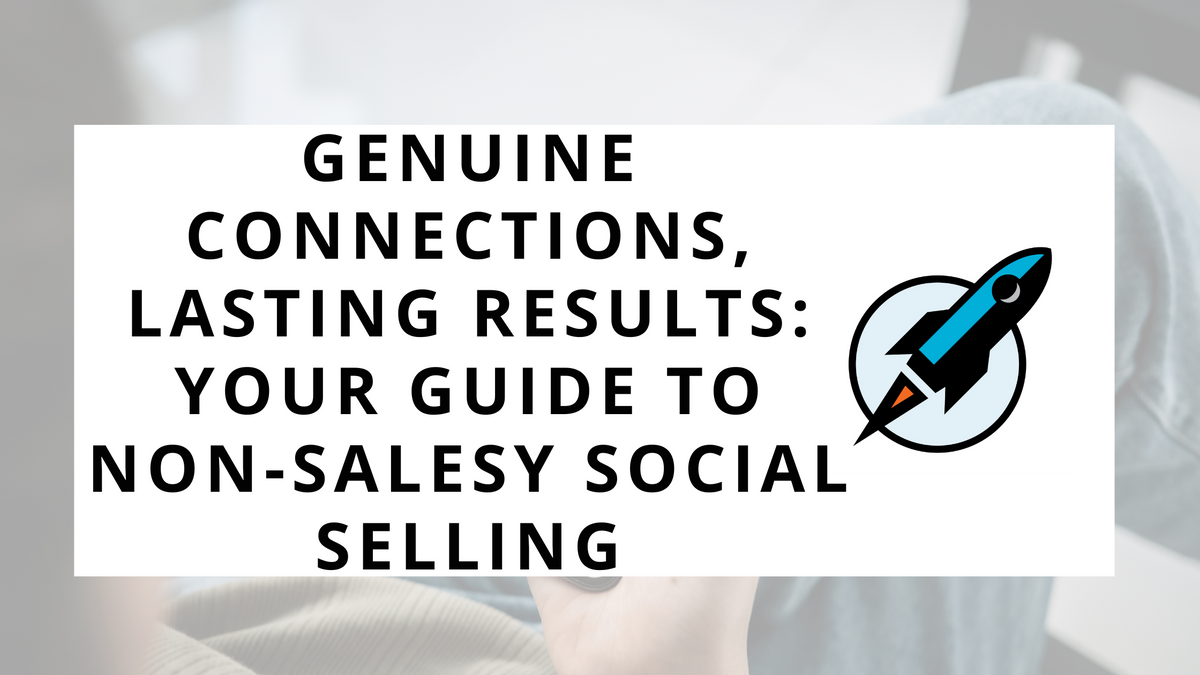Genuine Connections, Lasting Results: Your Guide to Non-Salesy Social Selling

Social media has become a powerful tool for sales professionals to connect with potential clients, build relationships, and drive business growth. However, the line between effective social selling and coming across as too salesy or spammy can be thin.
One of the biggest fears I hear from reps is - “I don’t want to sound too salesy.”
It’s a valid concern. Nobody wants to be that person who constantly posts about their products and reeks of desperation - especially on a social media platform.
So in this edition of Sell with Social, we'll explore some strategies to help you strike the right balance and leverage the art of social selling for genuine, meaningful interactions.
Most People Aren’t Salesy Enough
Before we dive into how NOT to be too salesy or spammy through social selling, I want to stop and make one major observation on this topic: most people aren’t salesy enough.
In fear of being too salesy, most people NEVER try to sell through digital channels.
They avoid talking about their business, their solutions, or how they help their customers. They never “offer” to help and simply stay on the sidelines.
Don’t let this be you.
If you never ask for the sale, you’ll never get it. If you don’t provide the path, nobody will walk down it.
You need to get comfortable with the idea of selling if you are going to reap the benefits of social selling. No exceptions.
So while this article is about how not to be salesy, keep in mind most people need to be more salesy.
5 Ways to Avoid Being Salesy
Let’s dive in. Here are five ways that you can sell with social, without being overly salesy or spammy:
1. Educate Your Audience
Rather than bombarding your audience with constant product pitches, aim to educate and inform.

Share industry insights, trends, and useful tips that showcase your expertise. By providing valuable content, you establish yourself as a credible source, and potential clients will be more receptive to your sales messages when they come later down the digital sales funnel.
2. Focus on Solving Problems
When discussing your offerings, focus on the solutions they provide rather than the features. Explain how your product or service can address specific challenges your audience faces, making your messages more relevant and appealing.
Remember, your ultimate job as a sales professional is to help solve your customer's problems.
They “hire” your product or service to perform a job for them. Articulate how your product or service uniquely addresses the customer's needs and solves their problems better than alternatives. It's not just about the features, but how those features fulfill the specific job.
3. Use Clear Calls-to-Action
Make it easy for your prospects to take action. Use crystal clear calls-to-action that provide a next step in the process.
You should include both direct and transitional calls to action:
- Direct Calls to Action - These high-intent calls to action directly move the prospect into the sales pipeline. Examples are direct messages, estimate forms, or a booking a demo button.
- Transitional Calls to Action - These early-stage calls to action continue to nurture a prospect before they become an active deal. Examples are signing up for a newsletter, attending a webinar, or downloading a guide.

By providing various types of calls to action, you can provide a path for your audience to convert, whether they are ready to buy or still in the early stages of purchasing.
4. Be The Guide, Not the Hero
When engaging with prospects, it's essential to position yourself as the guide rather than the hero. Be the Yoda, not the Luke Skywalker.
By assuming the role of the guide, you create a dynamic in which you empathize with your prospects' needs and concerns. You listen actively, ask probing questions, and truly understand their pain points. Instead of emphasizing your own achievements, you direct your energy toward providing tailored solutions and guidance. This not only builds trust but also positions you as a partner who is genuinely invested in the success of your prospects.
In contrast, positioning yourself as the hero may come across as self-centered and potentially alienate prospects. It can unintentionally overshadow their needs, making them feel like they're just a means to your own ends.
5. Be Authentically You
It’s cliche, but one of the best ways to avoid being salesy is simply being authentic (unless your true personality is sleazy).
People want to work with people they know and trust. Being authentic online will enable you to develop meaningful relationships with your audience, and make people more comfortable with the idea of buying from you.
“I feel like I already know you” is the best phrase to hear the first time you meet with a prospective customer. This should be music to your ears. If you consistently post social content that is authentic to who you are, I guarantee you’ll begin to hear this.
Aim for 80/20
And if all else fails, a simple model to remember is 80/20. Aim to have 80% of your content be educational and entertaining, and the remaining 20% promotional.
80% Educational Content:
The majority of your social media content should focus on providing value to your audience. This can include educational posts, informative articles, how-to guides, tips, industry insights, inspirational quotes, and other content that helps your audience learn something new or solve a problem.
20% Promotional Content:
About 20% of your content can be promotional in nature. This includes posts that directly promote your products, services, events, or any other offerings. Using the tips above, your promotional posts should be crafted in a way that adds value to your audience and resonates with their needs and interests, rather than being overly salesy. This approach maintains engagement while still allowing you to showcase your offerings.

For this week’s action items, I want you to start social selling. Start taking action on ways to sell in an authentic, and non-salesy way through your social strategy.
Here are the two action items I want you to take:
- Review Your Social Selling Strategy - Take a look at your current social content and profile. How much of it selling? If you are like most people I work with, it’s not enough. The fear of being salesy/spammy might be holding you back. Or vice-versa, you may be in the minority of people pushing selling too often. Reference the 80/20 approach to see where you stand.
- Implement Selling Strategies - Next, I want you to start to implement some of the selling strategies outlined in the article above. Start educating prospects, solving their problems, and providing clear next steps to work with you. Once you accept that it’s possible to sell authentically online, you’ll find it easy to implement some of these strategies.
